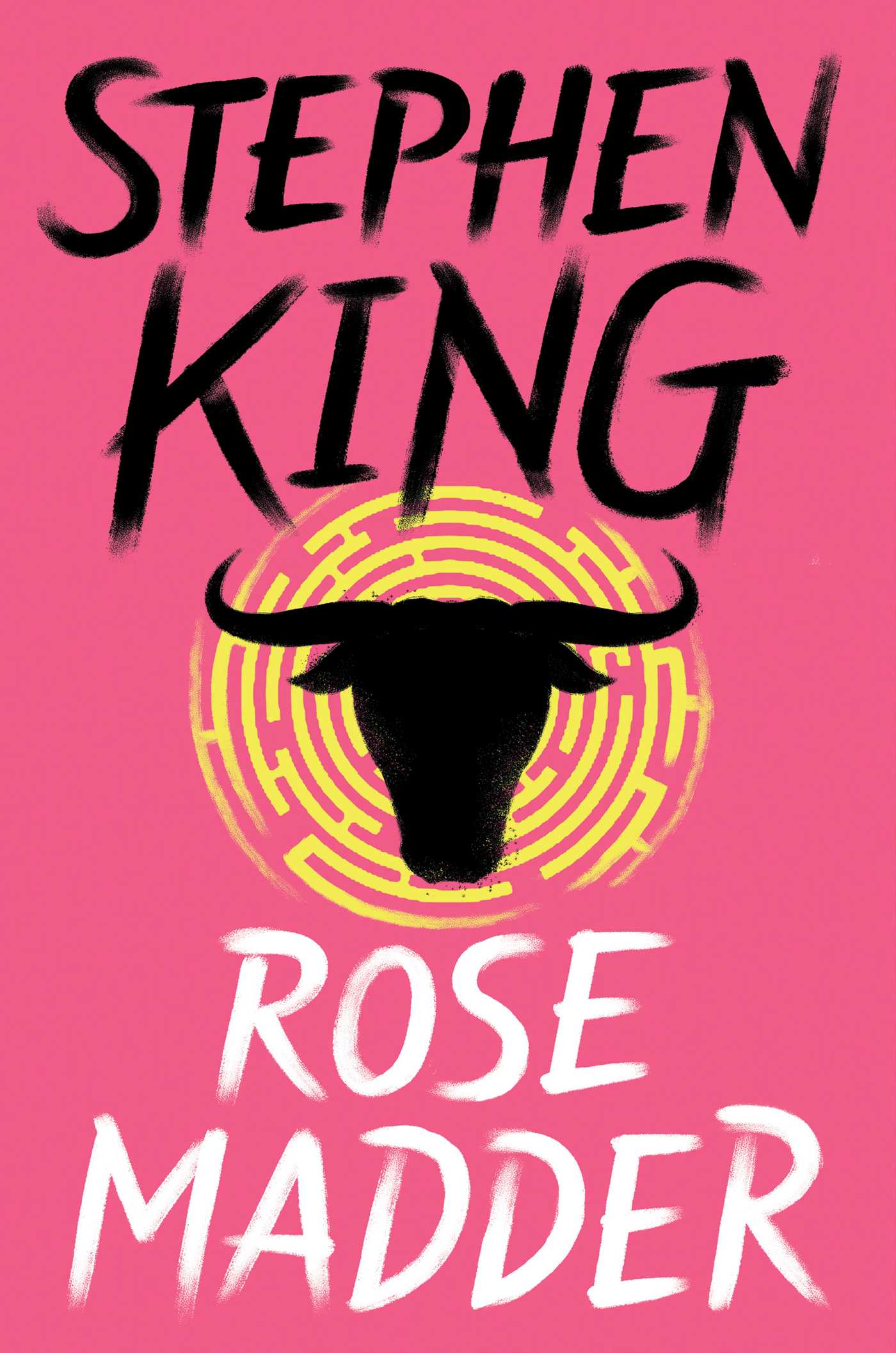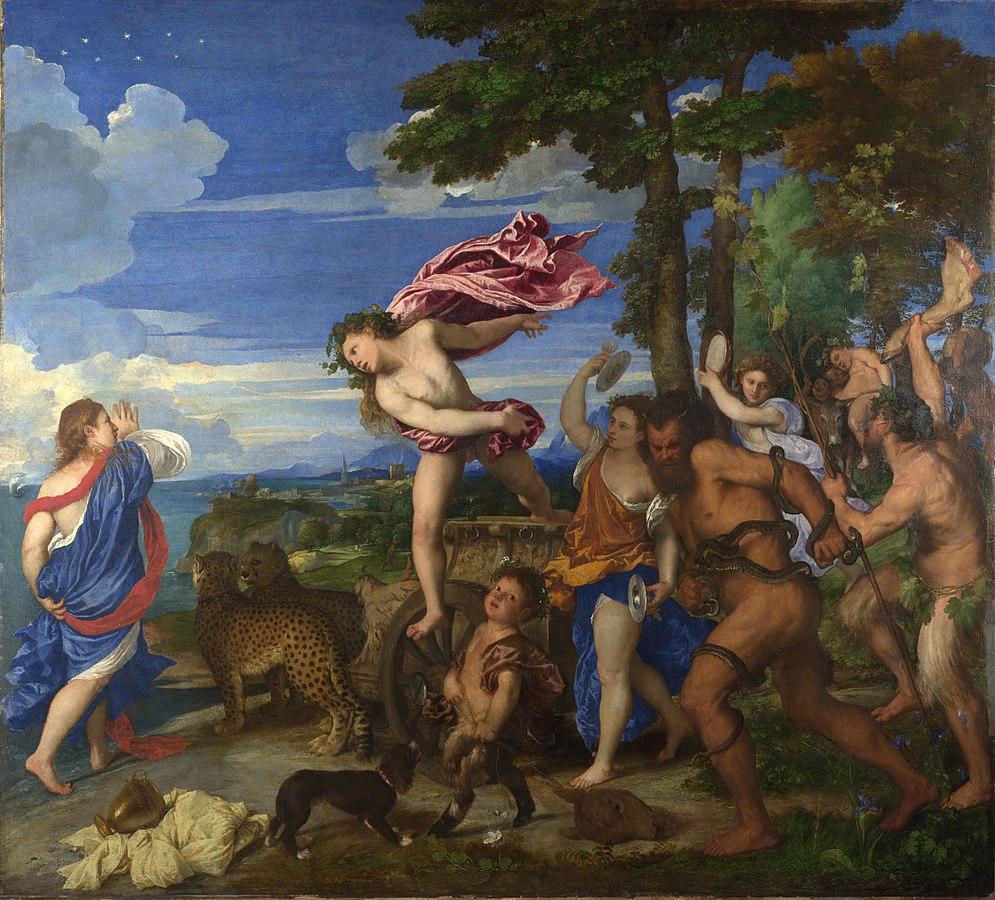Rose Madder, the Pinky Red of Stephen King's Worst Novel and Hieronymus Bosch's Perverted Playground
Cultural histories of unusual hues.
.
.
.
.
.
.
.
.
.
Stephen King’s 30th novel, Rose Madder, starts with a miscarriage. A woman named Rose sits on the floor bleeding from her womb as a man (her crooked cop husband) menaces somewhere in the shadowy background. He’s a villain built of “empty eyes” and hard fists, a man so aggressively racist, homophobic, and violent that to a 2018 reader he feels like an overindulgent parody of toxic masculinity. Later, after Rose has escaped her abuser (or so she thinks), she’ll find a magic painting leaning against a dusty shelf on the floor of a pawnshop. She buys the painting and becomes obsessed with its female subject.
The mystical artwork shows a blonde with a braid, standing on a grassy knoll, facing away from the viewer, her arm adorned with a gold torc and her body wrapped in the loose folds of a vivid pink-purple (rose madder) chiton. The woman in the picture is strong, while Rose is meek. The woman is angry, while Rose is cowering. Rose will come to call her doppelgänger Rose Madder after the textile dye used to color her dress (made from the roots of the Rubia tinctorum—common madder—plant) and her imagined personality—she’s so much like Rose, but madder.
This weird novel was published in 1995, at the “end of King’s fourth major arc: one that focuses on gender and violence,” according to James Smythe at The Guardian, who calls the book “sloppy and ill-thought-out.” He’s not wrong; it really isn’t King’s best work, and he damn well knows it. But I’m a sucker for stories about artworks and performed femininity, and this clunky novel is about both. From the moment we meet her, Rose is a bloody heroine, leaking red and seeing black. An everywoman, womb-empty and ever-wounded.

Her name is also a synonym for is the color most closely associated with femininity. In French, the word for pink is rose, and other languages have similarly easy to translate terms. (Spanish has rosado, German has rosa, and ditto for Italian.) These are also all words for a flower, and when capitalized, proper names for a gendered babe. But pink wasn’t always for girls, and even more importantly, it wasn’t always pink. Pink is nothing more than light red, and in many cultures, there is no conceptual basket to gather up all the pink-ish hues.
Ancient Greeks didn’t have a word for pink, nor did the Romans. (Don’t be fooled by Homer’s rosy fingers of dawn. “A Latin adjective roseus exists, of course, built upon the name of a flower [rosa], but it is a false friend,” writes Michel Pastoureau in Red: The History of a Color. “It does not mean pink but rather ‘bright red,’ ‘vermillion,’ ‘very beautiful red.’ It was often employed to describe the makeup used by women and fabrics that had been dyed.”)
Pink, as a concept, arrived in Europe in the late fourteenth century with shipments of brazilwood dye. As the color began to appear more often in clothing and paintings, early European languages began to seek words to describe this watered-down red. In French and Spanish, the flower chosen for the honor wasn’t a rose, but the carnation (otherwise known as “clove pink”), picked for its supposed resemblance to the pasty European complexion.

By Franz Eugen Köhler, Köhler’s Medizinal-Pflanzen – List of Koehler Images, Public Domain, Link
Although the line drawn between pink and red is a relatively recent border, rose madder is not. It’s the premier pink and an essential red. The name Rose madder comes from madder lake, which refers a plant-based textile dye made from roots of the common madder plant (a member of the coffee family) that had been grown in chalky, lime-rich soil for two years. To make this dye, ancient people would pulverize the sun-dried roots and cook them with water before adding a mordant. This bright and fragrant broth could turn natural cotton fabric a rich, vivid red (or a lighter pink, if the dye was less potent or the mordant less effective). According to The Pigment Compendium by Nicholas Eastaugh, Rose madder (also known as pink madder, not to be confused with Frank Ocean’s poetic “pink matter”) is a “variant of madder lake produced by selective extraction and deposition of pseudopurpurin, an anthraquione compound present in the dyestuff extracted from plants such as Rubia tinctorum L. and other Rubiacae species.”
It sounds complicated, but compared to some of the other colors out there—like Prussian blue or caput mortuum—it’s not. You can easily find recipes for making Rose madder textile dye online or you can just follow the blog Local Color Dyes, where one Massachusetts-based weaver, spinner, and dyer is documenting her experiments with plant-based dyes, including madder root, which she grows in her backyard garden. (Someone get this woman a TV show!) Rose madder paint was discovered slightly later than the dye, and it is made using a similar process. Instead of suspending the powdery fragments of the root in water and mordant, paint makers would mix it with a binding agent, like clay or alum. The resulting material was thick enough to apply with a brush, but it tended to fade quickly when exposed to enough light.
In 1804 an English dye-maker discovered that if you added sulfuric acid to the mixture, you could create a longer lasting paint that was less “fugitive” than the original. A few decades later, Berlin-based dye maker Carl Theodor Liebermann discovered a synthetic way to produce the color. With a few tweaks (and the help of William Henry Perkin, the inventor of mauve) this version of Rose madder could be made far more cheaply and in much larger quantities than the original. It was more durable and long-lasting, and so for the most part, the synthetic paint replaced the plant-based one, despite the fact that they don’t create quite the same red hue (the plant produces a more purplish red with blue undertones, while the synthetic version reads a little more orangey, more crimson). Fortunately for color purists, you can still buy Rose madder paint from British color makers Winsor & Newton. Their website chirpily declares that they make “Real Madder and Proud of It.”
Historians have been able to trace the use of madder root back thousands of years and across cultures. Madder root pigment was found in Tutankhamun’s tomb and in the ruins of Pompeii. It gets a shout out in the Talmud and Hippocrates mentioned it, too. Druids used it to color their robes, and some early Irish tribes even supposedly fed it to their horses to color their teeth red (this probably made them look pretty intimidating in battle). Madder can be used to create a variety of hues, from peachy yellows to brilliant crimson, and the roots of common madder were once used to treat jaundice, palsy, sciatica, bruises, and “melancholy humor.” (This is due in part to their belief in the Doctrine of Signatures. Because madder roots could be used to create a red-colored liquid, many medieval doctors thought it would help with ailments of the blood or issues of the uterus.) Madder was also historically used to induce abortions, which is fitting since King’s Rose only gets madder after her violently induced miscarriage.

By Titian – National Gallery, Public Domain, Link
Even if you’ve never heard of Rose madder or madder-based dyes and paints, you’ve seen the brilliant red and warm pinks that result from soaking and pounding the yellow-flowered perennial. Raphael, Rubens, and Vermeer all used Rose madder in their works, though they were also known to use vermillion and other crimson shades. In contrast to many of the reds available at the time, Rose madder has a slightly purplish tinge (it’s a “cool red”). One of my favorite examples of Rose madder in art history comes from Titian. In Bacchus and Ariadne, he depicts the moment when the god Bacchus (wrapped in a pinky purple Rose madder shawl) comes to rescue Ariadne (who was dressed, as per gender norms of the time, in delicate Virgin Mary blue), who had been abandoned on the island of Naxos by her lover, Theseus. It’s a bittersweet moment. Ariadne is being rescued, which is nice and all, but Bacchus is about to hit it and quit it. (Hence her look of fear.) Wine-drunk gods don’t make great husbands, though as a consolation prize, Ariadne did get turned into a constellation, which I suppose is preferable to being stranded on an island—but not by much.
The runner up in this unofficial contest for “Best Use of Rose Madder by a Dead Man” is The Garden of Earthly Delights by Hieronymus Bosch. Bosch reportedly used quite a bit of madder lake for his figures, and nowhere is that tendency more visible than in his watermelon-hued garden. Against a backdrop of spring green grass and azure blues, pink-bodied nudists frolic and play (and murder and rape and stick things up their asses and premasticate with birds and snuggle with piglets). Though many of the bodies in the foreground are bone white, some are painted a light, sugary pink (I think of this as a Will Cotton pink). Green may be the predominant color in the piece, but pink is the color that structures the painting. In the center of his triptych, Bosch created a pink wheel that pulls the eye around and around to a dizzying effect.

De Jerónimo Bosch – Galería online, Museo del Prado., Dominio público, Enlace
While pink hasn’t always been viewed as a girly color, it has always had certain sexual connotations, which long predate Aerosmith’s nasty rock ode to the blushy hue. Even today, people tend to view red as a masculine color associated with power and aggression, and pink as a feminine color, associated with softness, sex, and breast cancer. While some have claimed that so-called Millennial pink is a gender-neutral color (the “genderless mascot” of America’s nonconforming youth), I call bullshit on two counts. First, “Millennial pink” isn’t one color—it’s a group of hues that range from light blush to dusky rose to peach. Second, the color is being used primarily by companies who market directly towards women—Glossier, Thinx, etc. Rose, whether we’re talking about a Millennial version or just plain old pink, continues to be read as female.
However, it does feel like a fitting color for our current moment. Not only are Americans engaged in a very public debate about the pains of living and working in a female-coded bodies, but we’re also seeing a rise of woo-woo wellness and beauty products, and rose has a major presence in that realm, too. According to New Age author C.W. Leadbeater, godfather of American spiritualism and one of the most influential members of the Theosophical Society, rose is the color of our healthiest “vitality globules.” He believed there were seven colors of etheric atoms, which he could see with his third eye (together, these atoms form a person’s aura).
In contrast to the “livid grey of fear” and the “hard, dull brown of selfishness,” rose-colored aura atoms shone with “pure affection.” Were you to spend enough time with a vitality-deficient person, you would walk away feeling depleted because those types “draw the rose-coloured atoms away from us by suction.” (Or in modern day wellness-speak, they are “psychic vampires.”) Fortunately, there is a cure. Spend enough time with pine trees and eucalyptus, two plants that Leadbeater said were “charged” with pink atoms, and you’ll immediately feel better. It’s not universal health care (a beloved goal of pinko liberals) but maybe it’s worth a shot.
